Studio Visit
Step Inside Hernan Bas’s Little Havana Studio, a Converted Mechanical Shop, Home to His Warhol Drawings and Flamingo Magnet Collection
The artist's most recent works are currently on view at Lehmann Maupin, New York.
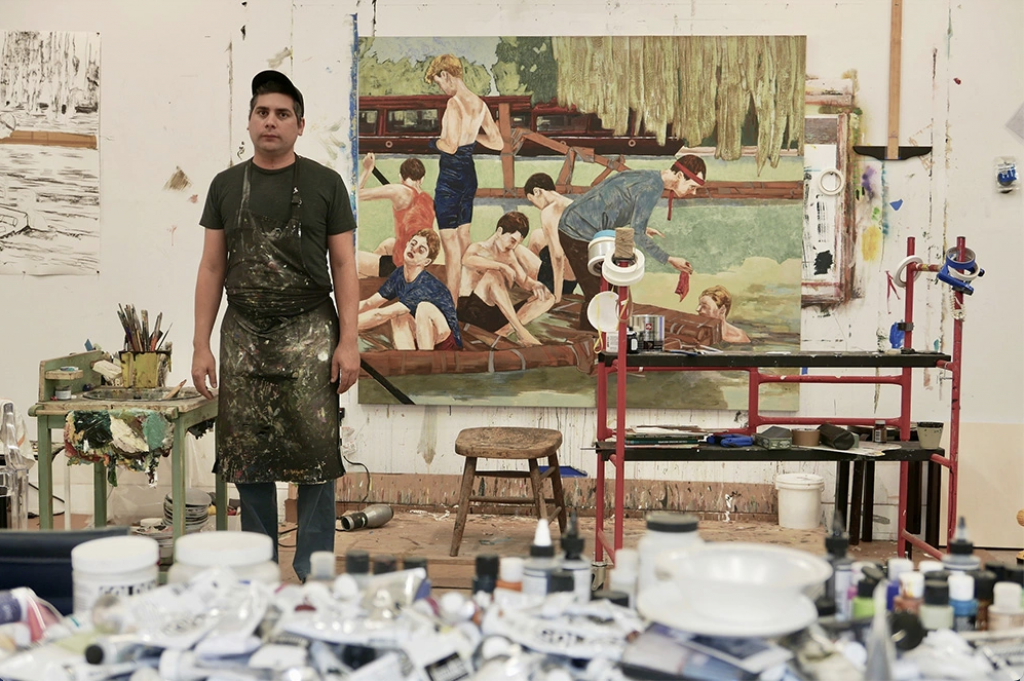
The artist's most recent works are currently on view at Lehmann Maupin, New York.

Katie White

Artist Hernan Bas has filled his Little Havana studio with a kaleidoscopic whirlwind of materials: paints, hundreds of books, artworks, and even magnets and seeds can be found in the converted mechanical shop. There, just walking distance from his home, the Miami native spends long days carefully constructing his highly sought-after, decadently referential artworks, which blend imagery drawn from pop culture, religion, literature, kitsch, and the history of art. These gorgeously rendered works are marked by Bas’s dexterous technical ability and saved from a too-pretty perfection by the artist’s own defining sense of humor.

Hernan Bas, Conceptual Artist #18 (2023). Courtesy of the artist and Lehmann Maupin.
Bas’s most recent works are currently on view in “The Conceptualists: Vol. II“ at Lehmann Maupin’s New York location (on view through June 17). The exhibition marks the artist’s sixth solo presentation with the gallery and is a continuation of his “Conceptualists” series, which he began in 2021. The acrylic paintings draw from Bas’s own fascination with conceptual art and center around an imagined artist’s eccentric pursuits (in one painting, for instance, the artist embarks on a road trip, creating faux roadside memorials). Looking around Bas’s studio, one can scout out his inspirational fodder in every nook and cranny of the space, from a set of Warhol’s pre-Pop drawings kept under glass to his extensive library of art-historical materials.
Recently, Bas welcomed us inside his one-of-a-kind studio where he keeps the TV on and browses his “towers of Lazy Susans.”
Tell us about your studio. Where is it, how did you find it, what kind of space is it?
My studio is in Little Havana, a historic neighborhood just west of downtown Miami. Both of my parents’ families lived nearby when they first came to the U.S. from Cuba. My home is within walking distance, so that was a big deciding factor (I’ve never had a driver’s license). The space itself is a modest-sized old industrial space, formerly a mechanical shop in the 1940s or ’50s, and was an environmental testing lab before I took it over and gutted the space.
Do you have studio assistants or other team members working with you? What do they do?
No, just me.
How many hours do you typically spend in the studio, what time of day do you feel most productive, and what activities fill the majority of that time?
I’m in the studio nearly every day, usually late morning until 7 p.m. or so. I feel pretty productive the entire time…I’m at work! (I am a bit of a workaholic.) If I’m not going to work, why go into the studio? When I’m not physically painting, I’m in the library or online doing research. I paint with acrylics but even that doesn’t dry fast enough for me, so between dry times is when I hit the research button…or water the cactus.
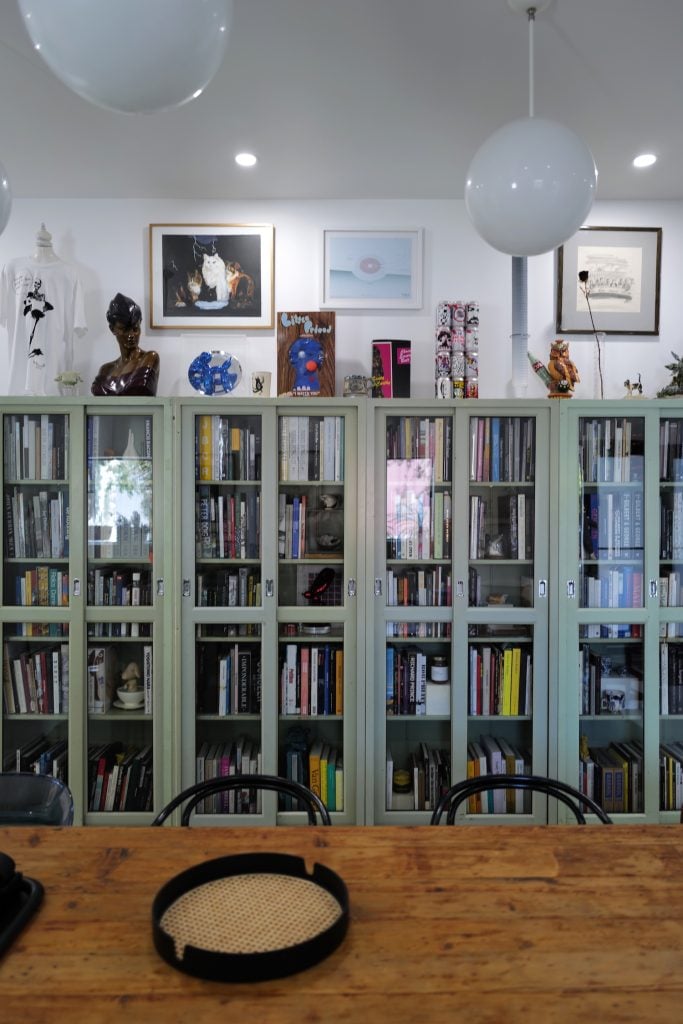
View of Hernan Bas’s library. Courtesy of the artist.
What is the first thing you do when you walk into your studio (after turning on the lights)?
I turn on the TV. Some people might find it odd, but I work with a TV on all day. It’s mostly white noise; I hate working in silence, but also it becomes a way of researching while working. The stuff I tend to have on doesn’t always bear fruit, but sometimes an odd story or obscure fact on Ancient Aliens, The Unexplained or History’s Greatest Mysteries takes me to the web for a deeper dive.
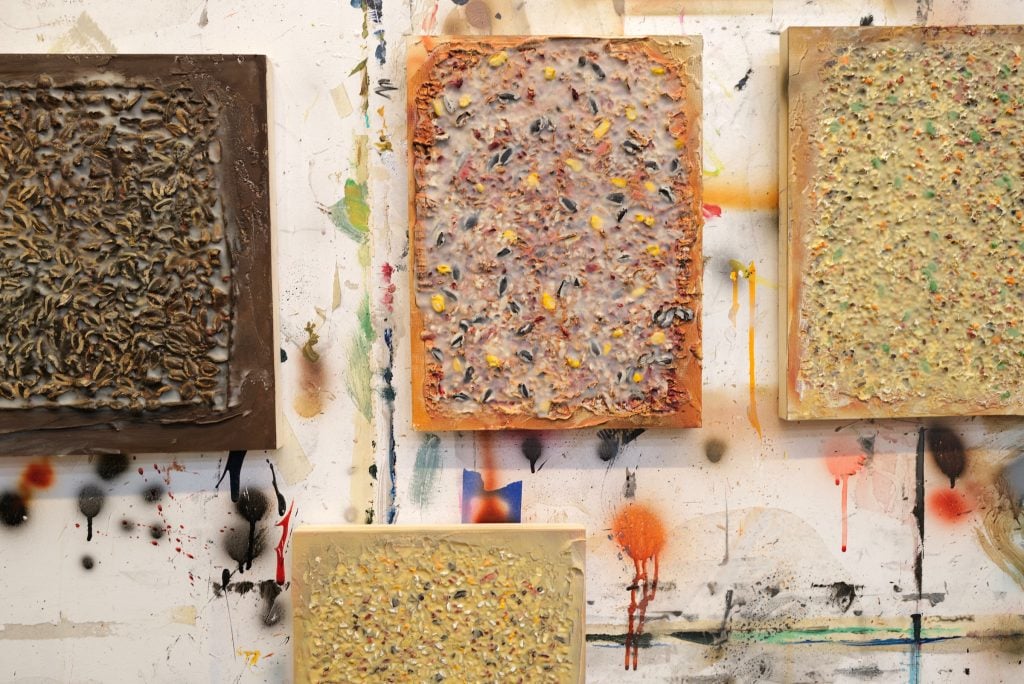
Seed studies. Courtesy of the artist.
What are you working on right now? Please send us a few smartphone shots of a work in progress—or photos of different works in various states of completion—in a way that you think will provide insight into your process.
I just finished a much-needed total studio clean-out, which has me excited to start fresh when my next batch of blank canvases arrives this week. In the meantime, I’ve been making drawings and planning out the last of the “Conceptualists” series, a few of which are currently on view at Lehmann Maupin in New York. One of the next “conceptual artists” constructs green burial markers/headstones made out of birdseed and suet. To get the right “seed” texture, I’ve been making flat silicon molds I can stamp into thick wet paint. You can buy these kinds of flat molds— typically meant for fondant decoration for cakes—but I couldn’t find one that looked right, so I made my own.
The molds only took a day or two, but it’s not as easy as ‘press it in the paint and done.’ I then need to paint the individual seeds and find the right medium to coat them in to mimic the “fat” or gelatin used to make those suet bricks people use in bird feeders….This is a good example of the moments I often find myself in at the studio, thinking, “You’re doing what today?” Trying to perfectly match what a gallon of stage blood looks like on Easter morning is another recent example.
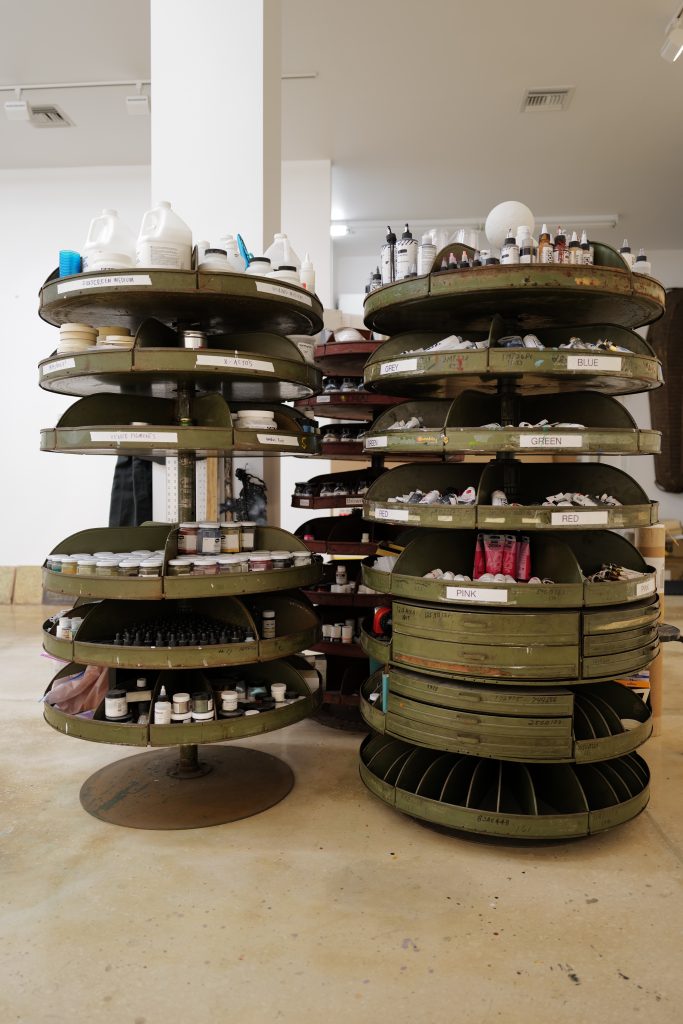
Rotating storage bins. Courtesy of the artist.
What tool or art supply do you enjoy working with the most, and why? Please send us a snap of it.
Not sure if these qualify as a tool, but the most useful item in my studio has proven to be my three vintage industrial rotating storage bins. They are basically towers of Lazy Susans, originally used to organize different-sized nuts and bolts in workshops, but they have been a lifesaver for organizing paints, etc. Before getting them I dealt with ridiculous piles of paint tubes on a long table, all buried together—it would take me half an hour to find the color I was looking for! Also, if you have limited wall space like I do, the fact that they’re freestanding is a huge bonus.
How do you know when an artwork you are working on is clicking? How do you know when an artwork you are working on is a dud?
Every work starts with a very specific concept, so it’s rare that I start a canvas without vetting the idea first for an extended period of time. That usually weeds out the duds in advance, but If the idea doesn’t hold water and turns into what I call an “impossible composition,” then the preliminary drawings tend to give me the heads-up to abandon it. An “impossible composition,” for me, is an idea, scene, or image that just can’t be described successfully within a painting: the story is too big, too layered, or too obscure to make into a relatable image. I was obsessed with “Duck Architecture” (look it up) for a while earlier this year, but there was no way I could make a good work about it. At least not yet.

Prints by Matthew Brannon in Hernan Bas’s studio. Courtesy of the artist.
What images or objects do you look at while you work? Do you have any other artists’ work in your studio? If so, please share a phone pic and tell the story behind it.
I have a lot of works by other artists in my studio. Most of it is in a front room that doubles as my library and repository for my collection of oddities. Nearly all of them are prints or works on paper that are safely framed under glass, or small sculptures in glass cabinets. I fear the ability of airbrush paints to “wander” too much in the air… I had an incident using some acrylic-based spray paint that left a thin layer of pink dust particles everywhere! Luckily, it didn’t stick to anything, but imagine a cotton candy-colored dust on top of every horizontal surface within a ten-foot radius of a painting…
That aside, as you walk in the studio you’ll find a pair of old Matthew Brannon prints of faux movie posters, The House that Bled to Death and Satan’s Bedroom, just above a collection of models of the “Amityville Horror” house. There’s Bas Jan Ader’s In Search of the Miraculous, an etching by Félicien Rops, a tower of PBR cans covered in stickers by Pruitt & Early, a bronze bust of a woman by Patrick Nagel, etc., There’s a bunch more, but the one thing I would grab if a fire broke out—even ahead of my own archive boxes—would be the small grouping of early ‘pre-Pop’ drawings by Andy Warhol hanging in the office space.
What’s the last museum exhibition or gallery show you saw that really affected you and why?
I recently caught the Art Institute of Chicago’s “Van Gogh and the Avant-Garde: The Modern Landscape.” Alongside some great Van Goghs I hadn’t previously seen, there were also some dreamy soft-focus drawings by Seurat I’ve always wanted to see in person. The odd thing about the show was the lighting: I thought I was having some temporary sun blindness, but in fact, it seemed like whatever kind of lights were used (LEDs?) combined with the pale green wall color to cast everything in a pinkish glow. A little white frame around a Seurat study became a muted pink, and the painting itself became softer too. In the end, I thought, this kinda works, maybe I should experiment with some pale mauve frames and matting.
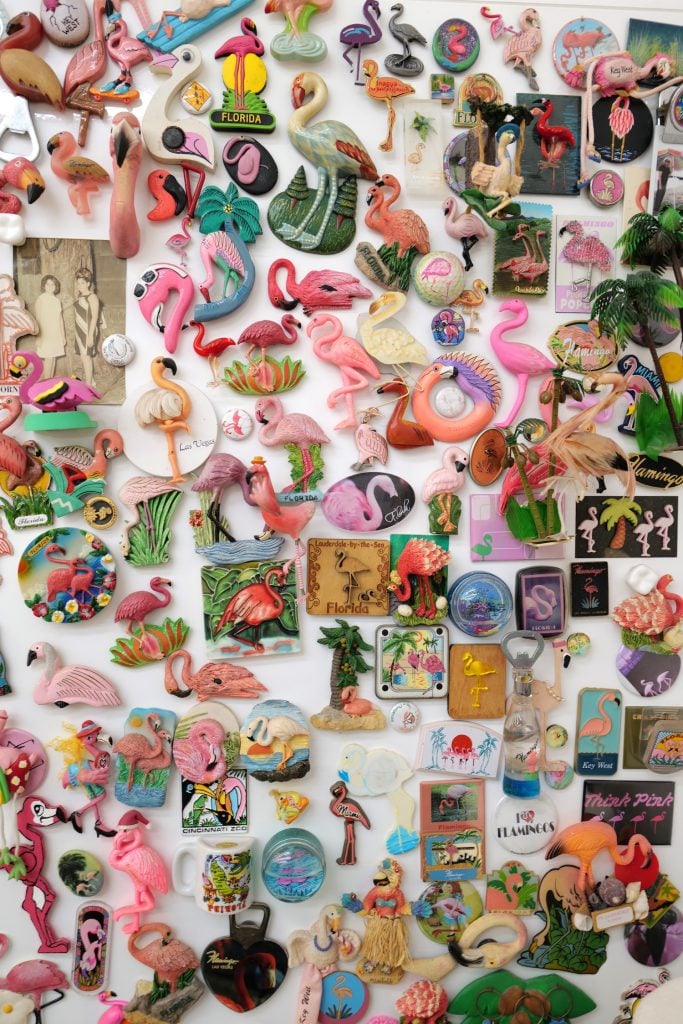
Flamingo magnets. Courtesy of the artist.
Is there anything in your studio that a visitor might find surprising?
Most visitors are drawn to my flamingo magnet collection on the side of the fridge, but the object that raises the most eyebrows is the 18th-century wicker cooling casket hanging on the wall.
Describe the space in three adjectives.
Peculiar. Personal. Private.
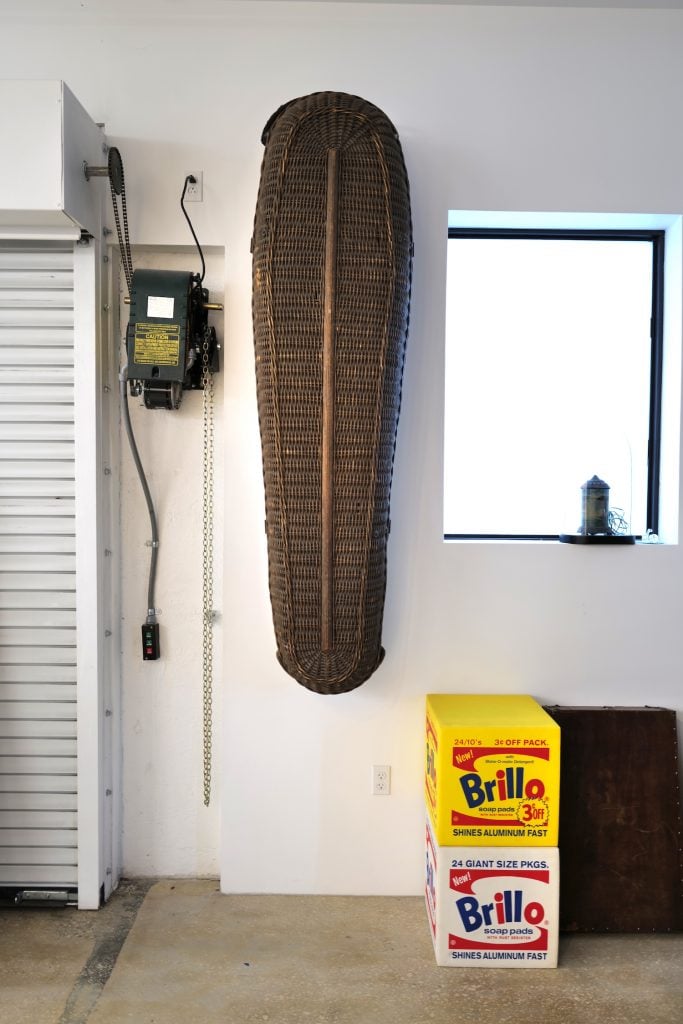
A wicker casket hanging in Hernan Bas’s studio. Courtesy of the artist.
What’s the last thing you do before you leave the studio at the end of the day (besides turning off the lights)?
Make sure I have my garbage bag to toss out. I live in the tropics, so I make sure not to leave any food scraps in the trash to avoid the unpleasant giant roach surprise we in Miami are accustomed to.
What do you like to do right after that?
Lock the door and toss the bag in the dumpster.